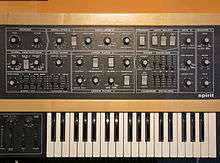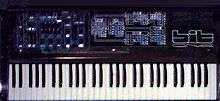Crumar
Crumar was an Italian electronic musical instrument manufacturer established by Mario Crucianelli in the late 1960s,[2] which manufactured synthesizers and keyboards during the '70s and '80s. Its name stands for "CRUcianelli and MARchetti", the names of Crucianelli and business partner Marchetti.[2] The company appears to have grown out of the Crucianelli accordion company and also continued to manufacture accordions under both names.
.png)
.jpg)
.jpg)


.jpg)
History and products
Crumar started out manufacturing electronic pianos and string synthesizers, such as the Compac-piano (1972/1973), Compac-string (1973), Pianoman (1974) and Stringman (1974), the functions of which were combined in 1975 with the Multiman (also known as the Orchestrator), and in 1977 with the Multiman-S.[2] The company was also known for "clonewheel" organs made in the 70's and 80's, such as the Organizer (1974), Organizer T1 (1978) and T1/C (1981), T2 (1978), and T3 (1981).[2]
In 1978, Crumar released their first full-fledged synthesizer, the DS-2, which had one of the earliest digitally controlled oscillators (DCO).[3] Crumar synthesizers are comparable and contemporaneous to Moog synthesizers and other analog synthesizers; in fact, the Crumar Spirit synthesizer (1983) was designed by Bob Moog himself, along with Minimoog co-designer Jim Scott and Tom Rhea (who wrote Moog manuals).[4] In 1984,[2] Crumar began producing polyphonic synthesizers utilizing DCOs under the Bit name (Unique in the US).[4] The Performer is a polyphonic analog Strings and Brass machine produced at the end of the 1970s and is slightly compact with just 49 keys and is fully polyphonic (can play all 49 notes simultaneously). Programming is simple and clearly laid-out with just 15 sliders and a few buttons. A solid black chassis and wood end-cheeks round out this classic and often overlooked string machine. The Performer is best remembered for its Strings more so than its Brass and was used by Duran Duran.
In the early 1980s, Crumar formed a design/distribution collaborative with New York-based Music Technology (MT) in an effort to commercialize the Bell Labs Digital Synthesizer. Crumar and the MT designers worked in conjunction with some respected names in electronic music to produce the Crumar GDS (General Development System)[5] in 1980, and the Digital keyboards Synergy[6] in 1981. These synthesizers, which used additive synthesis technology and phase modulation, were bulky and cumbersome, but were state-of-the-art at the time. The complexity of this project, along with Japanese competition (notably from the Yamaha DX7) contributed to the company's eventual downfall.
Crumar ceased trading in 1987, just as they were about to launch a high-quality sampler at the lower end of the market.
In 2008 the Crumar brand was acquired by a new Italian company that soon began producing new keyboards under the Crumar name, including the Baby Grand piano (introduced at the 2008 Musikmesse), Bassman bass synth, and Mojo clonewheel organ.
In 2018 a digital electric piano called Seven was introduced. It featured modern day technology in a wooden vintage 1970's style case.
.png) Crumar T2 Organizer
Crumar T2 Organizer.png) Crumar T2 Organizer
Crumar T2 Organizer Crumar keyboard
Crumar keyboard
Crumar users
- French Space Rock band, Rockets performed with many Crumar synths.
- Italian band Pooh and composer Vangelis used the Crumar Compac in 1973.
- Liam Howe of Sneaker Pimps used a Crumar Roadrunner 2 on their Splinter album (1999).
- Keyboardist Derek Sherinian records with a Multiman-S.
- Space jazz musician Sun Ra occasionally played the Crumar DS-2.
- Duran Duran keyboardist Nick Rhodes used the Crumar Performer.
- Pioneering Berlin School electronic musician Klaus Schulze used several Crumar instruments over his career, particularly on the albums Timewind (1975) and Moondawn (1976); the album Dig It (1980) heavily features the Crumar GDS.[7]
- It can also be seen in the Mark Ronson's Bang Bang Bang (2010) music video and is referenced in the song The Colour of Crumar on the same album.
- Madness keyboard player Mike Barson used a double-keyboard Organizer T1, as well as a Vox Continental throughout 1979 and 1980.
- Composer Wendy Carlos used the GDS on the soundtrack of the film Tron (1982), where it was employed to augment badly recorded orchestra cues. She also used both it and its sister keyboard, the Synergy, on her album Digital Moonscapes (1984), programming all of the sounds used on it. Those sounds were later offered for the Synergy.
- A Crumarwas used in Latin Music, particularly in "grupero" bands of the 1970s, '80s, and '90s, like that of the Regional Mexican band Grupo Bronco (known for some time as "El Gigante de America") which used the Crumar "Multi-Man" Orchestrator .
- Russian rock-band Alpha (ru) used Crumar in 1980 - early 1990. It can be seen in the many concert videos and photos.
- Soviet-russian keabordist Pyotr Podgorodetsky used Crumar Performer used in late 1970′s- early 1980′s during that time when was in rock-band Mashina Vremeni (ru)
See also
- List of Italian Companies
- Clonewheel organ
- Elka (Italian synthesizer manufacturer, also established by Crucianelli family)
- Bell Labs Digital Synthesizer
References
- "Bit One/Bit 01/Bit 99". Sound On Sound. August 1998. Archived from the original on 9 June 2015.
- Bassi, Enrico (2005–2007), Crumar Museum (in Italian), archived from the original on October 3, 2011, retrieved 3 January 2014
- Bassi, Enrico. "Crumar DS-2 Reverse Engineering" (in Italian). Ebax Sinthy Production. Archived from the original on 29 February 2012. Retrieved 3 January 2014.
- Reid, Gordon (2001), "Spiritual Enlightenment – Crumar Spirit Analogue Monosynth (retro)", Sound On Sound (July 2001), archived from the original on 2011-12-25
- "CRUMAR/DKI GDS SYSTEM & SYNERGY", Synthony.com, archived from the original on 1997-01-15, retrieved 2014-01-01
- Aaron Lanterman, Digital Keyboards Synergy Preservation Page, retrieved 2014-01-01
- Mueller, Klaus D. "Klaus Schulze's Instruments". Klaus D. Mueller. Retrieved 3 January 2014.
External links
| Wikimedia Commons has media related to Crumar. |
- CRUMAR WEB SITE
- Vintage Synth Explorer - An online vintage synthesizer archive. This site has good images and descriptions of Crumar synthesizers.
- Technical view on Crumar Performer
- History and technical overview of the Crumar Spirit
- |webpage dedicated to Crumar performer with some sounds and pictures